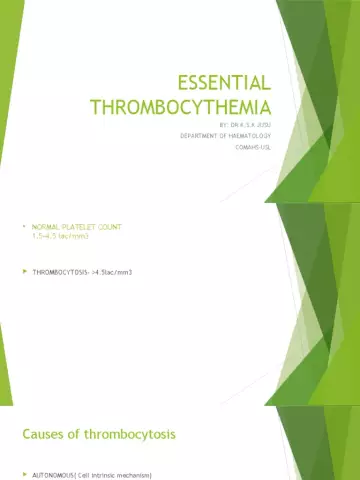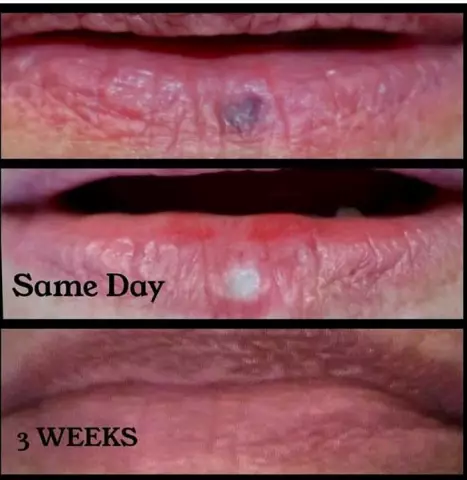- Author Rachel Wainwright [email protected].
- Public 2023-12-15 07:39.
- Last modified 2025-11-02 20:14.
Thrombocythemia

Essential thrombocythemia is a chronic megakaryocytic leukemia related to myeloproliferative diseases. The process involves stem cells in the bone marrow. The disease is by its nature hemoblastosis, that is, tumor. The number of megakaryocytes, and then platelets, increases uncontrollably. Essential thrombocythemia is rare. The prevalence is 3-4 cases per 100 thousand of the adult population. People aged 50-60 are more susceptible to this disease. Women get sick more often than men. As with any cancer, the exact causes of essential thrombocythemia are unknown. A connection with radiation damage to the environment is noted. The role of other factors is not excluded.
Thrombocythemia Symptoms
The disease is characterized by a long course without visible manifestations. The progression of the disease is slow. Often months, or even years, pass from the first recorded changes in blood tests to the appearance of the first complaints. The symptoms of thrombocythemia consist of a simultaneous tendency to form blood clots and bleeding. The mechanism of occurrence of these phenomena includes violations on the part of platelet aggregation (both upward and downward). Cerebral, coronary and peripheral arterial thrombosis are characteristic. With essential thrombocythemia, pulmonary thromboembolism and deep vein thrombosis of the legs are possible. From bleeding, gastrointestinal, pulmonary, renal, and skin hemorrhages are more common. In addition, with thrombocythemia, enlargement of the spleen and liver may develop. These symptoms occur in 50 and 20 percent of patients, respectively. Numbness and decreased sensitivity are observed in the fingers and toes, earlobes, and the tip of the nose, associated with impaired blood circulation in small vessels. Some patients may have pain in the hypochondria and along the intestines. Many sufferers lose weight. Sometimes enlarged groups of lymph nodes appear. There are many nonspecific symptoms of thrombocythemia: general weakness, headache, decreased ability to work, fatigue, itching of the skin, frequent mood changes, fever. Sometimes enlarged groups of lymph nodes appear. There are many nonspecific symptoms of thrombocythemia: general weakness, headache, decreased ability to work, fatigue, itching of the skin, frequent mood swings, fever. Sometimes enlarged groups of lymph nodes appear. There are many nonspecific symptoms of thrombocythemia: general weakness, headache, decreased ability to work, fatigue, itching of the skin, frequent mood swings, fever.
Diagnostics of the thrombocythemia
Diagnosis of the disease begins with the registration of a large number of platelets in a general blood test. The diagnosis is made when thrombocytosis exceeds 600 thousand per μL after excluding reactive thrombosis. Platelets have varying degrees of functional impairment. Prothrombin time, activated partial thromboplastin time, bleeding time, platelet life within normal limits. In the bone marrow, puncture results show increased cellularity and megakaryocytosis. Precursor cells of platelets are gigantic and dysplastic. Non-strictly specific genetic abnormalities in essential thrombocythemia are JAK2V617F and MPLW515L / K mutations.
Differential diagnosis of thrombocythemia and secondary thrombosis
It is difficult to distinguish essential thrombocythemia from secondary thrombosis caused by amyloidosis, infection, cancer, or other factors. The American College of Hematology has developed the following differential diagnostic criteria:
- the number of platelets more than 600,000 per μl in two consecutive blood tests performed with an interval of 1 month;
- no known cause of reactive thrombocytosis;
- a normal number of red blood cells;
- the absence of significant fibrosis in the bone marrow;
- absence of the Philadelphia chromosome;
- enlargement of the spleen;
- hypercellularity of the bone marrow with hyperplasia of megakaryocytes;
- the presence in the bone marrow of pathological cells in the form of colonies;
- normal levels of C-reactive protein and interleukin-6;
- absence of iron deficiency anemia;
- in women - polymorphism of genes of the X chromosome.
The more matches are found, the more evidence is in favor of essential thrombocythemia.
Thrombocythemia Treatment

If the patient is diagnosed with essential thrombocythemia, then he should be selected individual treatment in accordance with the existing scheme. Therapy is especially intensively prescribed for those at risk of thrombosis. These patients include elderly patients with diabetes mellitus, hypertension, and dyslipidemia. Treatment of thrombocythemia with cytostatics is most often indicated for such patients. These are chemotherapy drugs that reduce the activity of cell division. For a long time and with success, hydroxyurea (0.5-4 g orally daily) has been used to treat thrombocythemia. Because of its ability to cause leukemia (for example, acute myeloid leukemia), this drug is not prescribed for children.
Thrombocythemia can be treated with interferon-alpha. It is used especially widely in pregnant women, since it does not harm the fetus. In general, the high cost and poor tolerability of interferon-alpha are a limitation. The initial dose of the drug is 1 million IU three times a week, then the dose is increased to 3-6 million IU three times a week. About 20% of patients are forced to stop treatment, as they are greatly worried about fever, pain in joints and muscles, nausea, loss of appetite, flu-like symptoms.
Anagrelide is also used to treat thrombocythemia. This drug selectively inhibits the maturation of megakaryocytes, having little effect on other hematopoietic germs. The initial dose of the drug is 2 mg per day, the maximum dose is 10 mg. The medicine has side effects related to the cardiovascular system. Characterized by vasodilatation and increased heart rate, edema. If the patient already has any cardiac pathology, then it is not advisable for him to prescribe anagrelide. Under the action of the drug, the transformation of thrombocythemia into myelofibrosis can occur. Because of all these phenomena, anagrelide is used mainly for intolerance to hydroxyurea and interferon-alpha.
Thrombapheresis can be successfully used in combination with acetylsalicylic acid (325 mg orally per day) to prevent thrombosis in thrombocythemia.
Treatment of essential thrombocythemia with folk remedies
Folk remedies are sometimes used by patients in the treatment of this disease. There are no studies on folk methods that have proven their effectiveness. Any such methods are used by the patient at his own peril and risk. Most likely, the positive changes are associated with the placebo effect, that is, self-hypnosis. It is fundamentally important for the patient to inform the attending physician about what else is used independently to combat the disease. Treatment of essential thrombocythemia with folk remedies includes the use of fasting and various herbal remedies. The most often recommended are infusions of blueberries, muzzle seeds and a decoction of the string.
YouTube video related to the article:
The information is generalized and provided for informational purposes only. At the first sign of illness, see your doctor. Self-medication is hazardous to health!






